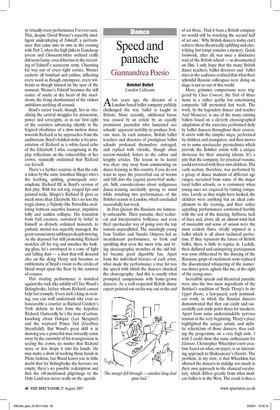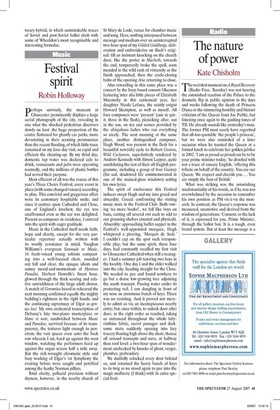Speed and panache
Giannandrea Poesio Bolshoi Ballet London Coliseum Afew years ago, the director of a London-based ballet company publicly challenged the way ballet is taught in Britain. More recently, additional havoc was caused by an article by an equally prominent journalist who lamented our schools' apparent inability to produce firstrate stars. In each instance, British ballet teachers and directors of prestigious ballet schools professed themselves outraged, and replied with vitriolic, though often narrow-minded, letters to the editor and lengthy articles. The lesson to be learnt was clear: stay away from commenting on dance-training in this country if you do not want to open the proverbial can of worms and fall into the (again) proverbial snakepit. Still, considerations about indigenous dance-training inevitably sprang to mind while watching two performances of the Bolshoi season in London, which concluded successfully last week.
In Don Quixote the Russians are famously unbeatable. Their panache, their technical and interpretative brilliance and even their spectacular way of going over the top remain unparalleled. The amazingly young Ivan Vasiliev and Natalia Osipova led an incandescent performance, so brisk and sparkling that even the more trite and tiring choreographic stretches of the old ballet became good digestible fun. Apart from the individual bravura of each artist, what made the performance a true hit was the speed with which the dancers attacked the choreography. And this is exactly what prompted comparisons with home-grown dancers. As a well-respected British dance expert pointed out on his way out at the end of act three, 'Had it been a British company we would still be watching the second half of act one.' Why British dancers today can't achieve those theatrically uplifting and electrifying fast tempi remains a mystery. Quick footwork, after all, was once a distinctive trait of the British school — as documented on film. I only hope that the many British dance teachers, ballet directors and ballet stars in the audience realised that what their splendid Russian colleagues were doing on stage is not so out of this world.
More, grimmer comparisons were triggered by Class Concert, the first of three items in a rather quirky but entertaining composite bill presented last week. The work, by the legendary dancer and teacher Asaf Messerer, is one of the many existing ballets based on a cleverly choreographed adaptation of the exercises performed daily by ballet dancers throughout their careers. It starts with the simpler steps, performed by children and youngsters, and then moves on to some spectacular pyrotechnics which provide the Bolshoi artists with a unique showcase for their amazing talents. It's a pity that the company, for practical reasons, could not travel with their own children. The early section, therefore, was performed by a group of dance students of different age ranges, recruited from some of the major local ballet schools, as is customary when young ones are required by visiting companies. Lovely as they might have looked, the children were anything but an ideal complement to the evening, and their rather appalling performances contrasted harshly with the rest of the dancing. Stiffness, lack of lines and, above all, an almost total lack of musicality and sense of unison were the most evident flaws, vividly exposed in a ballet which is all about technical perfection. If they represent the future of British ballet, there is little to rejoice in. Luckily, their deflated and uninspiring participation was soon obliterated by the dancing of the Russians; gasps of excitement soon replaced the discontented whispering of the numerous dance goers, aghast, like me, at the sight of the young ones.
Incredible speeds and theatrical panache were also the two main ingredients of the Bolshoi's rendition of Twyla Tharp's In the Upper Room, a fast-paced, early postmodem work, in which the Russian dancers demonstrated that they can easily and successfully cast aside point shoes for sneakers. Apart from some understandable nervous tension at the very beginning, Tharp's piece highlighted the unique artistic and stylistic eclecticism of those dancers, thus ending the programme on a very high note. I wish I could show the same enthusiasm for Elsinore, Christopher Wheeldon's new creation based on what, on paper, is an interesting approach to Shakespeare's Hamlet. The problem, in my view, is that Wheeldon has allowed the dancers to indulge too much in their own approach to the classical vocabulary, which differs greatly from what modern ballet is in the West. The result is thus a weary hybrid, in which unmistakable traces of Soviet and post-Soviet ballet clash with some of Wheeldon's most recognisable and interesting formulae.










































 Previous page
Previous page